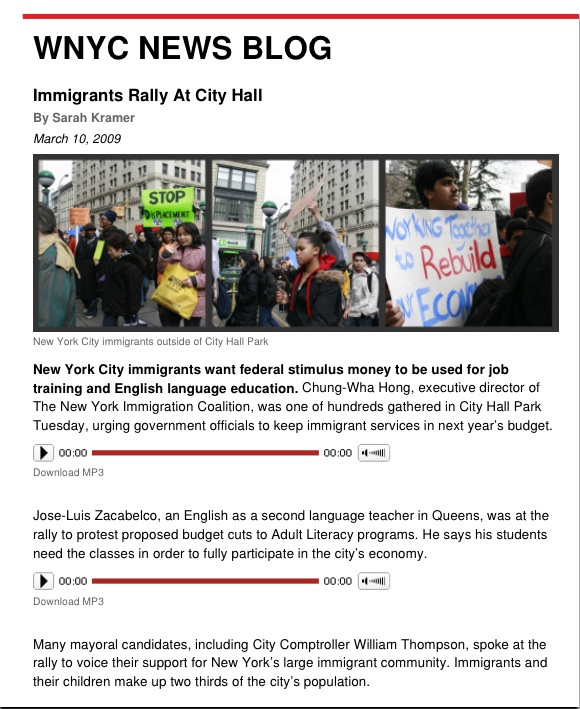Led a team of 9 people to coordinate all aspects of the largest annual advocacy event focused on the City Council, in New York City.
More than a thousand immigrant New Yorkers and their supporters gathered at Battery Park for a march to City Hall, where they urged the city to enact policies that will leverage their strength, commitment to hard work, and entrepreneurial spirit in order to survive the current downturn and help rebuild the city’s economy.
“The mayor has repeatedly said that immigrants are the driving force behind the city’s economy, and fixing our broken immigration system is a key step toward promoting long-term economic growth,” said Ms. Chung-Wha Hong, executive director of the New York Immigration Coalition, the organizer of today’s event. “We couldn’t agree more, but it doesn’t all rest at the federal level. The city must put out a bold plan of raising revenues from those able to pay, and providing the kind of training and education that allow low income and immigrant workers to be a major part of the city’s recovery strategy.”
Participants in the march and rally highlighted the need for the city to use fiscal stimulus funds to support crucial services for immigrant communities, as part of a broader workforce development initiative that will move New Yorkers into jobs and help others get the training they need to enter the workforce as the economy expands. “Immigrants are half of the city’s workforce,” said Gonzalo Mercado, executive director of El Centro del Inmigrante, “and account for a large portion of low-wage workers, toiling in the hardest conditions—which, in the current economy, have only gotten worse. The city needs to establish community job centers, which can provide workers with vocational training and ESL, legal help to combat exploitive working conditions, and crucial education on workplace health and safety. The time is now to provide these kind of comprehensive services geared to low-income workers.”
Learning English opens up economic opportunity, but the city provides only 60,000 seats in English classes for nearly two million New Yorkers who don’t speak English well,” said SJ Jung, president of YKASEC-Empowering the Korean American Community. “If the city is serious about getting its residents back to work, it must provide immigrants the chance to learn English.”
“If we want to revitalize our economy,” said Vladimir Epshteyn, executive director of the Metropolitan Russian American Parents Association , “then we need to make sure we prepare the workforce of tomorrow. For too long the city has allowed too many students to graduate high school without the basic skills to function in the economy; for too long, students still learning English have faced skyrocketing dropout rates. Last year, the city recognized the urgency of stemming the dropout crisis by creating incentives for schools to improve the education they provide to students still learning English. The city cannot afford to backtrack on this effort. Our children’s future is not a luxury we can give up in hard times.”
Participants in the rally also stressed the need for the city to preserve the safety net for city residents and emphasized how critical it is for city agencies to provide language assistance for non-English speakers. “We applauded Mayor Bloomberg’s executive order last summer calling for all agencies to provide language assistance to the two million New Yorkers who don’t speak English very well,” said Ana Maria Archila, co-director of Make the Road New York. “Especially at a time of great need, when government needs to be as effective as possible, it is vital for the city to make sure this order is fully implemented so it can communicate with all New Yorkers.”
Following the march and rally, in some two dozen meetings with senior administration officials, City Council members, and other elected officials, immigrant community members raised these issues and others, including the need to improve immigrant access to health care and health insurance, the need to safeguard safe and affordable housing, and the importance of making sure the city’s parks and open spaces are responsive to the needs of the communities where they are located.
The event was covered by numerous media organizations including NY1, El Diario, NY Daily News, and the NPR affiliate WNYC.

